Corry II (DD-463)
1941–1944
The second ship to be named for the late Lt. Cmdr. William Merrill Corry, Jr. (see Corry I (DD-334) for biography.
II
(DD-463: displacement 1,630; length 348'1"; beam 36'1"; draft 15'8"; speed 35 knots; complement 208; armament 4 5-inch, 2 40 millimeter, 7 20 millimeter, 5 21-inch torpedo tubes, 2 depth charge tracks, 6 depth charge projectors; class Gleaves)
The second Corry (DD-463) was laid down on 4 September 1940 at Charleston, S. C., by the Charleston Navy Yard; launched on 28 July 1941 and sponsored by Mrs. Jean C. Corry, the niece of Corry’s eponym, Lt. Cmdr. William M. Corry, Jr.
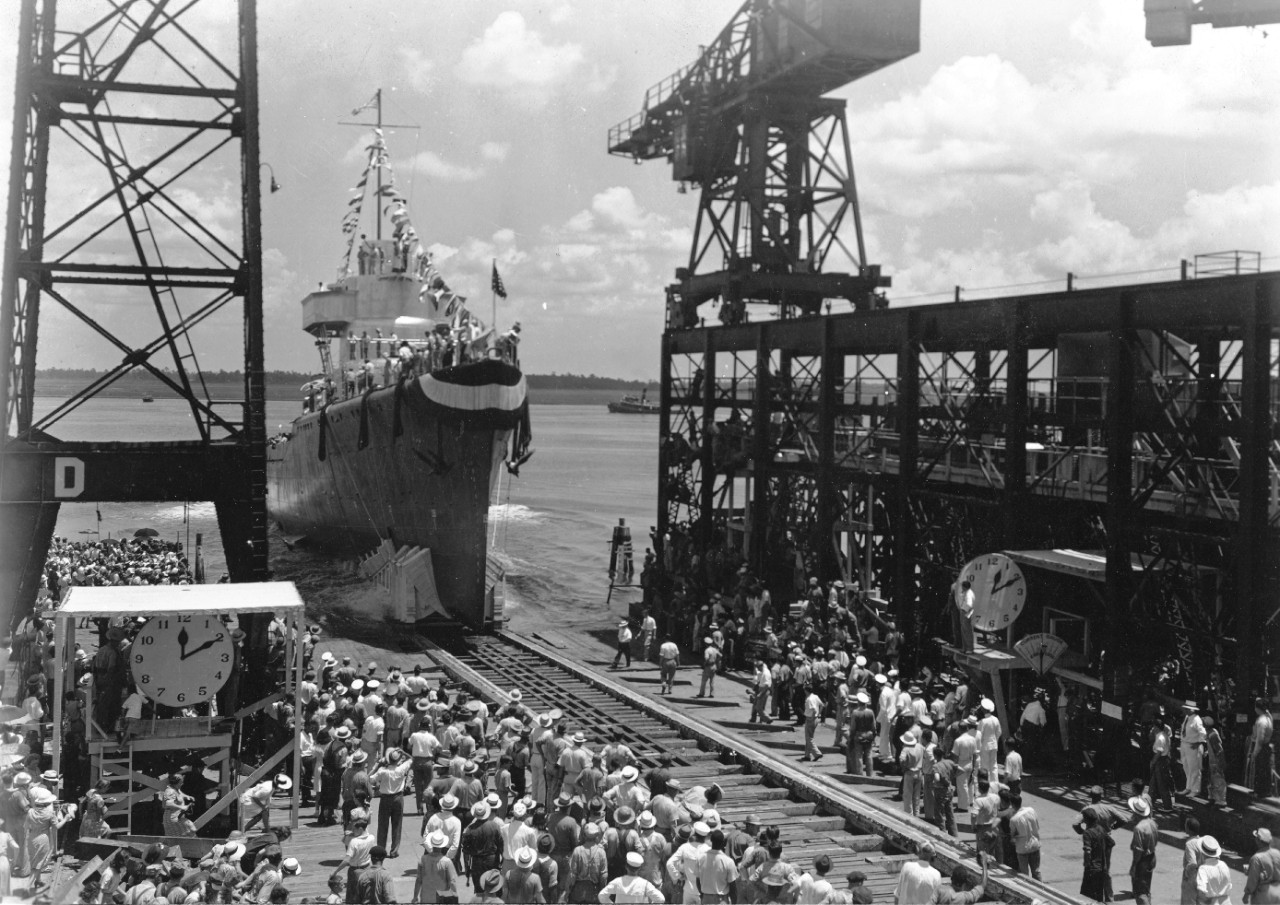
Commissioned on 18 December 1941, Lt. Cmdr. Eugene C. Burchett in command, and assigned to the Atlantic Fleet, Corry conducted her shakedown out of Casco Bay, Maine.

Following the completion of those drills she steamed back to Charleston, where she arrived on 5 May 1942. In mid-May, the ship departed Charleston and headed for Chesapeake Bay. On 18 May, she was moored to the dock at the U.S. Naval Academy in Annapolis, Md. From 18 May to 20 May, in concert with the Navy’s Radio Washington, the ship participated in certain special operations conducted in the Severn River. On 21 May, she set out on her first mission, escorting the British naval auxiliary Queen Elizabeth. She made her first stop at Brooklyn, N.Y., on 22 May, where she fueled and then shortly thereafter set out to rendezvous with the object of her mission. At dawn, on 23 May, Corry made contact with Queen Elizabeth and escorted her to New York Harbor.
On the same day that she safely delivered Queen Elizabeth to New York, Corry set a course for Bermuda. She arrived in Port Royal Harbor on 24 May 1942, and joined Task Force (TF) 26. As a part of the Task Force, Corry was assigned to be an anti-submarine screen for the heavy cruiser Augusta (CA-31), as they made the journey to Norfolk, Va. Following a short and uneventful voyage, Corry arrived at Norfolk with Augusta on 26 May. A few days later, on 31 May, operating under Commander TF 22, Corry set out with Augusta, and Forrest (DD-461), headed for Newport, R. I. They arrived there on 1 June, and Corry remained in that area for several days. While operating in that region, she escorted Indiana (BB-58) during the battleship’s sea trials.
On 2 June 1942, Corry, still with TF 22, left for Argentia, Newfoundland. During the course of the voyage she acted as a screening vessel for Augusta, as well as the carrier Ranger (CV-4). She remained with the aforementioned group in the waters around Newfoundland for several weeks, but eventually on 23 June, returned to her home port at the Boston Navy Yard in Massachusetts, to undergo routine repairs. Shortly after her repairs were completed, on 30 June, the destroyer rejoined TF-22 at Newport and set out for Trinidad on 1 July.
While en route to her destination on 4 July 1942, Corry sighted four men adrift on a life raft on the starboard bow, and altered course. Lt. (j.g.) John C. Dunn, MC-V(G), USNR, examined Ordinary Seaman Walter Haas, Fireman Harry Whitcotten, Able-Bodied Seaman Joseph P. Voliva, and Mess Boy Harold Dayse after they had been brought on board, and they revealed that they were survivors of the 3,588-ton freighter Ruth, Robert M. Callis, master, flying the house flag of the A. H. Bull & Co., Inc. The ship, carrying Manganese ore from Rio de Janerio, Brazil, to Baltimore, Md., had been torpedoed on 28 June by the German submarine U-153 (Fregattenkapitän Wilfried Reichmann in command). The torpedo ignited the ship’s magazine and she sank swiftly thereafter.
In recounting the tale of Ruth’s sinking, the merchant sailors stated that only moments after being stranded in the water at least three of them made it onto a life raft. U-153 rescued the other surviving crew member and brought him over to the raft, after which Fregattenkapitän Reichmann queried the Ruth’s survivors concerning “the name of their ship, number of crew, cargo, home port” and “whether any of the survivors were officers.” Apparently satisfied with the Americans’ responses the Germans then informed the stranded sailors that they were approximately 270 miles from the nearest shore but that they need not worry too much regarding their fate, as they were in an area frequently traversed by steamers. The survivors also attested that the submarine looked freshly painted, was “definitely German,” and that the crew – those appearing on deck exhibiting curiosity about the Americans – seemed very young, with the commanding officer appearing to be 23-24 years of age [he was actually 36]. Ruth’s survivors drifted for six days before they were rescued. For their sustenance during that time they indicated their good fortune in having a plentiful stock of “water, chocolate, and hardtack.”
Corry made port at Trinidad on 6 July 1942. She remained in the area conducting patrols until 8 July. She departed from Port of Spain on 31 July, and charted a course for Hampton Roads. She concluded the voyage on 5 August with her arrival at Norfolk, for an availability period. Up until 22 August, she participated in various exercises in Chesapeake Bay and then on 23 August, Corry departed for Boston with TF 22. On 30 August, she accompanied Augusta to Norfolk and then the same day set course for Colon, Panama.
Corry arrived at Colon on 3 September 1942, then sailed the next day in company with Rowan (DD-405) and Mayrant (DD-402) to escort Transport Division 6, en route to Norfolk. During the course of the voyage, on 10 September, Corry detected a submarine and went to general quarters. She dropped several depth charges but was unable to determine if her attack inflicted any damage. She steamed on and arrived in Norfolk on 11 September. Corry remained there for nearly a month, and then finally put back out to sea on 3 October, as a part of Task Group (TG) 22.1, headed for Bermuda. She arrived at her destination on 6 October, and remained there for a full week participating in exercises and conducting patrols. She returned to Norfolk on 14 October, and then a few days later she was steaming back to Bermuda again, arriving on 19 October.
As a part of Destroyer Squadron 10, TG 34.2, on 25 October 1942, Corry set out on a voyage to French Morocco. She arrived in her designated area on 8 November, where she participated in Operation Torch, the first major military venture undertaken by U.S. forces in the European theater that consisted of a joint U.S. and British invasion of Vichy French North Africa meant to dislodge Nazi forces from the continent and open the way for an invasion of Sicily and eventually Italy. Corry, Ranger, and Cleveland (CL-55), assumed positions north of Casablanca. Corry acted as a screen for Ranger and Cleveland, while Ranger commenced flight operations in support of the invasion.
At 1100 on 8 November 1942, one of Ranger’s planes, a Douglas SBD-3 Dauntless (BuNo 06619) from Scouting Squadron (VS) 41, piloted by Lt. Cmdr. Lamar P. Carver, VS-41’s commanding officer, with ACRM R. A. Miner in the rear seat, crashed into the water in Corry’s vicinity. Her sailors swiftly jumped into action and managed to successfully rescue both of the downed aviators. Following the conclusion of operations in the area, she departed on 16 November, along with Texas (BB-35), and arrived back at Norfolk on 26 November. On 27 November, she headed north to Boston and on the way served as part of a convoy with Merrimac (AO-37), Hobson (DD-464), and Trippe (DD-403), as far as New York. On 28 November, Corry and Hobson were detached from the convoy and continued on to Boston, where they arrived on 29 November.
During her ten days of availability at the Boston Navy Yard, Corry was overhauled. She had three 20-millimeter machine guns installed and additionally, on 2 December 1942, welcomed a new commanding officer, Lt. Cmdr. Lot Ensey. On 11 December, the destroyer set out for Casco Bay in company with Hobson and Maddox (DD-622), screening the battleship Massachusetts (BB-59). Just off Portland, Maine, Corry conducted anti-submarine operations and firing drills. Following her time in the Portland area, she anchored at Norfolk on 16 December.
The day after she arrived at Norfolk, Corry sailed in company with Montpelier (CL-57), Patuxent (AO-44), LaVallette (DD-448), Chevalier (DD-451), Strong (DD-467), and Taylor (DD-468). Only a few days into the voyage, on 21 December 1942, Montpelier sighted a submarine as it was submerging; neither Montpelier nor Corry were able to initiate an attack. Corry carried on and without any further excitement she arrived at port in Panama on 24 December. She had another short turn around, and was again out to sea the day after she arrived in Panama, escorting Bogue (ACV-9) back to Norfolk. The two ships arrived, without incident, on 31 December. Merely a week later she again departed Norfolk on 8 January 1943, and conducted exercises, as well as a patrol, in the Atlantic with TF 22. She returned to Norfolk on 30 January and was consequently drydocked for routine repairs.
Corry set out from Norfolk on 13 February 1943, acting as an anti-submarine screening vessel for TF 22 as it proceeded to North Africa. Having completed the venture without incident, she arrived back at Norfolk on 6 March.

For several months Corry continued to participate in numerous patrols and exercises along the eastern seaboard and in the area of the northern sea. This included voyages to Newport, Casco Bay, Boston, Argentia, New York, Halifax, and Nova Scotia. Of particular note, she conducted exercises with the British submarine HMS P-554 near Argentia in May. As of 9 August, Corry was anchored at Halifax.
On 11 August 1943, Corry set course for Scapa Flow, Scotland, as part of TF 22. She arrived without incident at Long Hope in the Orkney Islands, on 19 August. Once in the area, she participated in patrols and exercises with the British Home Fleet until the end of November. Her presence in the region was due largely to the German fleet’s raid on Spitzbergen; as British and U.S. naval forces acted to relieve the remaining garrison there. Corry assumed the role of an escort for Allied vessels and as often as possible placed herself between German bases and Spitzbergen. During that time, she remained generally in the area of Scapa Flow but did set out for Norway in early October, as part of Operation Leader, which would be the only U.S. Navy carrier operation carried out in northern European waters during World War II.
The raid, carried out by planes from Ranger, inflicted “appreciable losses” to two convoys off the Norwegian coast and to shipping in the harbor of Bodø, Norway. Ranger’s Grumman TBFs (VT-4), SBDs (VB-4), and Grumman F4Fs (VF-4) sank the Norwegian steamer Vagan and damaged the Norwegian steamer Topeka; but also sank German steamers Kaguir, LaPlata, and Rabat and transport Skramstad; damaged German tanker Schleswig and steamers Kerkplein and Ibis. German steamer Malaga was damaged by a dud bomb. Combat air patrol F4Fs from Ranger’s VF-4 splashed the only two German planes (Junkers JU 88D-1, 4N+EH from the first staffel, Fernaufklarungsgruppe [long range reconnaissance group] 22 and Heinkel HE 115B, K6+MH of the first staffel of Küstenfliegergruppe 406 [coastal patrol group]) that approached the task force. Neither German crew survived.
Corry made two other voyages to Akureyri Harbor, Iceland; and before completing her duties in the region, she participated in escorting HMS Anson in a meeting with a Soviet convoy in the area of Altafjord. She anchored in Hvalfjordur Harbor, Iceland, on 25 November 1943. Shortly thereafter, she set a course back to her home port in Boston, where she arrived without incident, on 3 December.
Corry charted a course for New Orleans, La., the day before Christmas [24 December] 1943. She arrived off New Orleans on 31 December, and then that same day set out on an escort mission, providing security for a convoy of merchant ships bound for Colón. She arrived with the convoy on 5 January 1944. The day after her arrival in Colón, she again set out to sea and accompanied the British escort carrier HMS Begum to Norfolk, where her and her charge arrived without inconvenience on 11 January. Corry’s crew got a few days of shore leave in Norfolk and then on 15 January, along with Forrest (DD-461) and Hobson, she left to escort Hornet (CV-12) on the new carrier’s shakedown near Bermuda.
As of 2 February 1944, Corry was back at Norfolk. She was attached to TG 21.16, and on 16 February, along with escort carrier Block Island (CVE-21), and destroyer escorts Thomas (DE-102), Breeman (DE-104), Bronstein (DE-189) and Bostwick (DE-103), she left port to conduct anti-submarine operations in the Atlantic.
On 29 February 1944, Corry went to investigate the sighting of a submarine by one of Block Island’s Grumman TBF-1 Avengers flown by Lt. (j.g.) Norman T. Dowty, USNR, which had dropped a sonobouy that obtained positive evidence of the proximity of a U-boat. Corry reconnoitered the area and upon locating the submarine she subjected it to a series of depth charge barrages. Unfortunately, she was ultimately unable to determine if any damage was done to the enemy. She made contact with another U-boat on 1 March, but a subsequent depth charge attack again failed to produce any conclusive results. Shortly thereafter she turned the search over to Bronstein and rejoined the task group. The task group reached Casablanca on 8 March.
Corry departed Casablanca with Block Island on 11 March 1944, with orders to search for a German milch cow [U-488] in the central Atlantic. On 16 March, Block Island launched hunter-killer teams (an Avenger teamed with a Wildcat) in the direction of the rendezvous indicated in intelligence reports. Late that afternoon, the German submarine U-801 (Kapitänleutnant Hans-Joachim Brans in command) was proceeding through a glassy calm sea just having completed gunnery practice, with a one gun crew working on a partially dismantled 37-millimeter mount; meanwhile other crewmen enjoyed the fresh air topside.
Lt. (j.g.) Charles Woodell and Lt. (j.g.) Paul Sorenson, flying a TBF and an FM, respectively, spotted and attacked the boat, Sorenson strafing and scoring hits at the base of the conning tower, killing one German sailor and wounding nine others. Woodell aborted his bombing run and Sorenson made a second pass, seeing a fire had broken out on the bridge, most likely from burning ammunition and deck planking. Woodell dropped two depth bombs that overshot the boat as she dove. Planes remained in the area for two hours until Block Island recalled them, after which U-801 surfaced and reported the attack as well as an assessment of her damage, prompting controllers at Brest, France, to order her to rendezvous with U-488 – the milch cow that Block Island and her consorts had been seeking.
Detecting aircraft soon thereafter, however, U-801 dove again. A search plane covered the area after nightfall while Corry headed in that direction, going to general quarters at 2015 on 16 March 1944, then changing course “to investigate a possible submarine sighting by carrier plane distant 9 miles.” She streamed her FXR [“Foxer”] gear and commenced a sound search at 16 knots. Although she stood down from general quarters at 2150, she continued the sound search into the mid watch, steaming darkened with FXR gear streamed. Before she reached the area in which U-801 was operating, the enemy submarine surfaced again to recharge her batteries. Only then, however, did Kapitänleutnant Brans and his crew realize that their boat was leaving a tell-tale oil slick to advertise her presence.
At 0210 on 17 March 1944, Block Island launched a TBF flown by Lt. (j.g.) Dowty after the escort carrier’s high frequency direction finder (HFDF, or “huff duff”) had picked up the U-boat only 45 miles away. Corry, meanwhile, went to general quarters at 0250 after picking up a radar contact, retrieving her FXR gear soon thereafter, then began methodically destroying, with machine gun fire, three radar decoy balloons employed by U-801 to keep the Americans off their scent. At 0335, Corry rang up 28.7 knots “to proceed to an area 18 miles west to assist plane 8 Doughty [sic – Dowty]…in submarine attack.” Reaching the area of the reported oil slick at 0414, Corry began a systematic sound search after first streaming her FXR gear. Finding nothing for the moment, the destroyer stood down from General Quarters at 0520.
Four hours later, her crew mustered on stations, no absentees and Corry began maneuvering to investigate an oil slick sighted by Lt. Theodore Elefter; who had relieved Dowty, as his low fuel state had compelled him to return to Block Island. The slick was marked with float lights dropped by Elefter, and Corry logged a sound contact at 0942, 1,500 yards distant; soon thereafter the sound of general quarters resounded throughout the ship. Slowing to 10 knots, then six, the destroyer resumed a sound search at 1031, picking up the scent a quarter of an hour later at 1,700 yards. She began maneuvering at 1047 to make a depth charge attack, and fired her first charge two minutes later. Corry regained the contact at 1059, then stopped to maintain it, then went ahead at 10 knots, firing a second charge at 1121.
Bronstein soon arrived on the scene to help. Sighting a periscope at 1126, Corry dropped an “emergency pattern” on the spot from her tracks, but five minutes later lost the contact. Changing speed to 12 knots, Corry stood down from General Quarters at 1142, then regained contact at 1154 bearing 180, 2,300 yards. Developing the contact as she maneuvered at various courses and speeds, noting poor echo-ranging conditions, Corry closed the contact eight minutes into the afternoon watch [1208], and began firing depth charges again at 1213½. Regaining sound contact exactly two minutes later, 1,250 yards away, Corry spotted U-801 surfacing “deep on [the] starboard quarter” and rang up 27 knots. She went to General Quarters again at 1219½.
Corry narrowed the distance to the battered boat, U-801’s seams having been opened, bilge pumps and some switchboards knocked out of commission and the periscope’s telemotor having failed, thus blinding her. Block Island, meanwhile, arrived on the scene with Thomas and Breeman. At 1220 Corry, cheered on by men on the carrier’s flight deck, opened fire with 5-inch and “all automatic weapons that could bear.” As she closed the range, she scored “numerous direct hits on conning tower and hull,” the fusillade slaying Kapitänleutnant Brans and his warrant quartermaster as soon as they gained the open bridge. Corry then began maneuvering to ram as the boat wallowed lower into the sea, the conning tower disappearing below the surface. Moments later, the bow rose out of the water and U-801 sank, stern first, into the Atlantic.
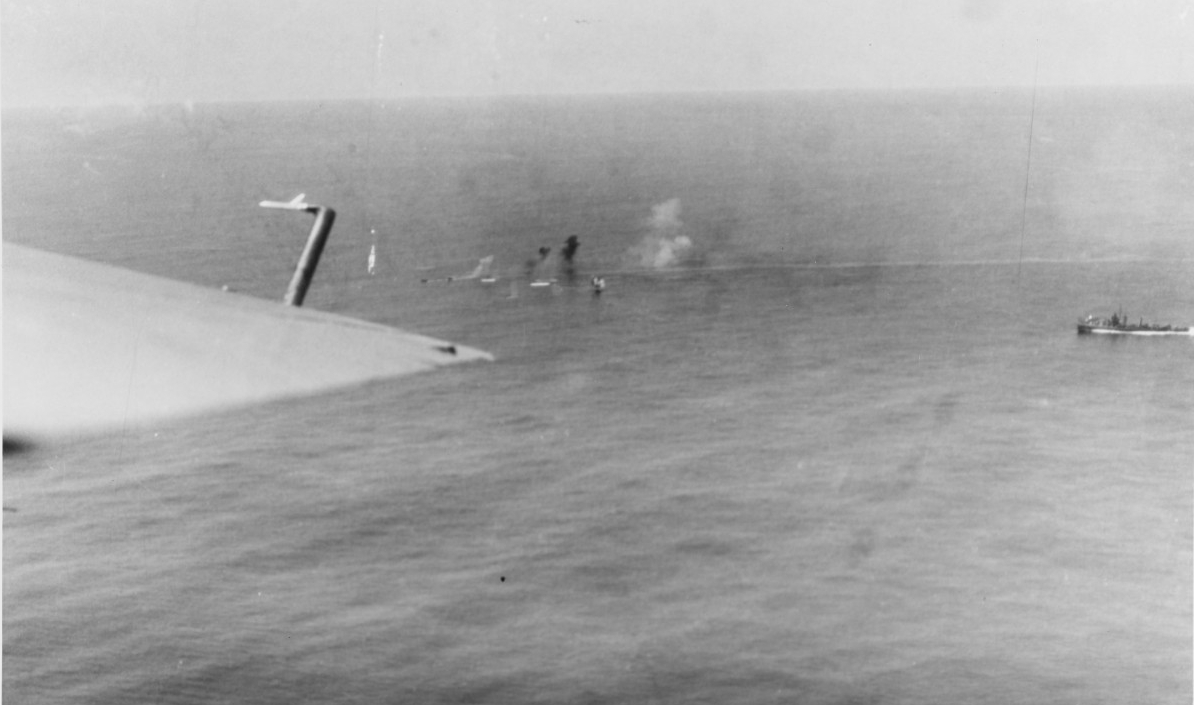
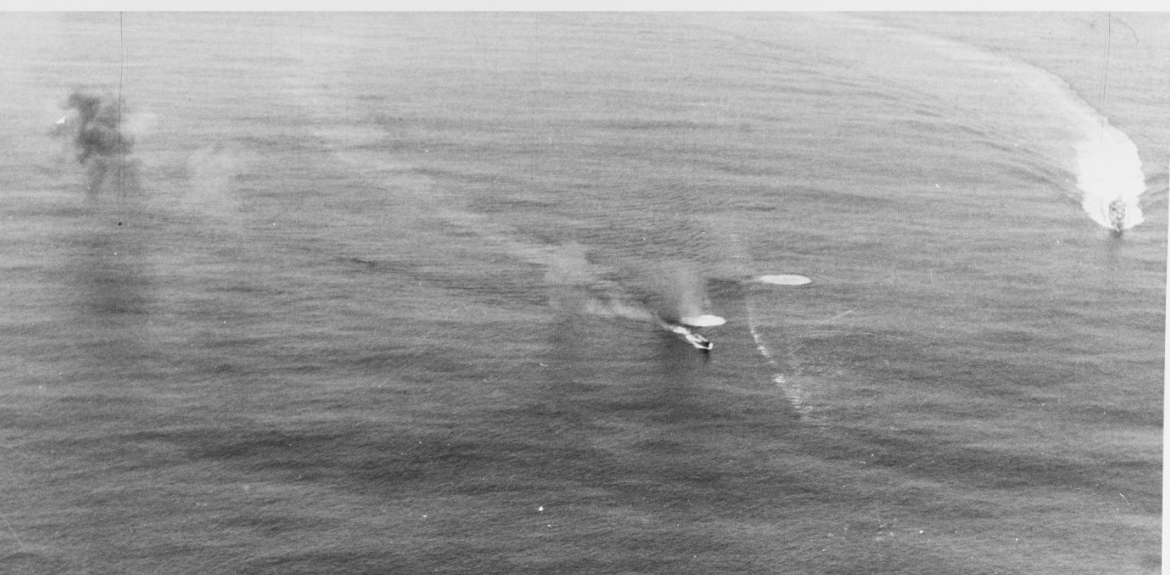
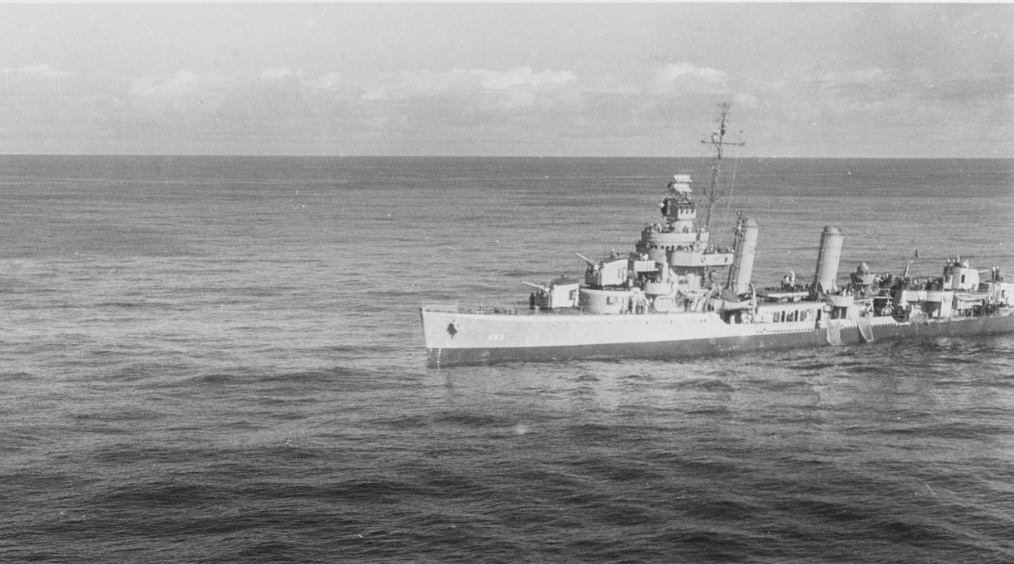
Bronstein closed in to aid in picking up survivors, while Corry lowered a boat to help in the endeavor. Between 1303 and 1417, she took on board four officers, the senior of whom was Leutnant zur See Fritz Bushman, one chief petty officer, two petty officers, six stretcher patients, and 34 men. At 1600 that same day, Corry began maneuvering to close the carrier, coming alongside at 1630 to refuel, a process that began at 1637, soon after which (1645) she began transferring U-801’s survivors, and captured material, to Block Island. While the fueling continued, Corry received 10 Mk.9 depth charges and 100 cases of flashless powder from the carrier; at 1859 she ceased fueling, having received 95,101 gallons of fuel oil. The transfer of prisoners of war (POW) and replenishment concluded, the destroyer pulled away and resumed her place in the formation.
On 18 March 1944, with U-488 still having eluded the Americans, Block Island’s task group scoured the seas during the daylight hours, with Corry briefly investigating what appeared to be an oily scum on the surface of the ocean early in the afternoon watch. That night, Block Island and her consorts steamed on a southwesterly course, hoping to locate another southward-moving U-boat. At dawn on 19 March, the carrier launched six hunter-killer teams that fanned out to a distance of 150 miles.
At 0726 on 19 March 1944, Lt. (j.g.) William H. “Tex” Cole, flying high in the skies spotted a submarine through the broken clouds to the left of the course he was flying. With the early morning sun at their backs, Tex Cole and Norm Dowty, his wingman, pushed over and pounced on the unwary U-boat. Cole swept around the stern to come up on the starboard quarter to allow Dowty, in the slower TBF, to move in directly from the starboard quarter. Meanwhile, Corry received orders “to assist aircraft attacking a submarine,” she rang up 28 knots and headed for the scene of the action.
Ahead of Block Island’s aviators lay the new German submarine U-1059, 23-year old Oberleutnant zur See Gunter Leopold, commanding, who, like a third of his crew, was enjoying an early morning swim while the boat was hove-to. Cole opened fire with his six .50-caliber machine guns, shooting up the decks, his bullets hitting home among the surprised Germans. Some of the enemy, however, managed to get the antiaircraft guns in action, 37- and 20-millimeter round striking Dowty’s Avenger as it thundered over their heads, and dropped down for a depth bomb attack.
Dowty’s bombs straddled U-1059, blowing the 1,100-ton submarine in two. Cole approached for a second strafing run but saw no useful targets as the boat was settling in two pieces with what seemed to be a pitiful few survivors struggling in the water. Dowty, meanwhile, turned sharply, perhaps to drop his Mk. 24 “Fido,” but his TBF dropped one wing, and spun into the ocean, a short distance from the sunken U-boat. While Dowty and his radar operator, ARM1c Edgar W. Burton, went down with the sinking plane, perhaps stunned by the impact of the crash, Ens. Mark E. Fitzgerald, a new pilot on an indoctrination flight and who had just celebrated his 24th birthday, managed to get free, finding a seat-pack life raft floating nearby. As he inflated the rubber boat, however, he heard faint shouting from where U-1059 had gone down. Tex Cole radioed Block Island that Dowty’s TBF had crashed, but that there was one survivor in the water. Immediately thereafter, Block Island detached Corry to retrieve that survivor.
Ens. Fitzgerald, meanwhile, became aware of a man, dog-paddling through the smooth seas toward him. Cole, who had remained overhead, saw the swimmer, and believing him to be another man who had escaped the downed Avenger, dropped a life raft. Fitzgerald called out to the man, asking him if could speak English, but the swimmer said “Nein.” The ensign motioned for the German to retrieve the life raft, which he did, then “showed him how to open it, inflate it, and climb in.” Fitzgerald then took the raft alongside and secured it, then began tending to the German’s wounds with the bandages and medicine he had in his first aid kit, an act of kindness that clearly surprised the enemy submariner.
Soon thereafter, two more men showed up, swimming toward them. Oberleutnant zur See Leopold, stark naked, and afflicted by a shattered knee and a torn scalp that was hanging over his face, climbed into a raft; meanwhile the other man hung on to the raft for dear life. “Did you fire on my plane?” Fitzgerald asked, “hitching his sheath knife within easy reach.” The query elicited Leopold’s guarded response: “You mad?”
“No, I’m not mad,” Fitzgerald replied, “just want to know.”
“Sure,” Leopold answered, now more relaxed, “my gun crews shot at it. We shot it down.”
Fitzgerald then bandaged Leopold’s wounds and that of the other recent arrival. The U-boat commander had noted how well he and his men had been treated, “You good fellow,” Leopold said, offering his hand, “Damn war!”
At 0834, Corry had made radar contact on Block Island’s planes some 22½ miles distant, then went to General Quarters at 0900. She fired her automatic weapons at a discarded fuel tank a quarter of an hour later, then sighted men in the water off her port bow at 0927, slowing to 16 knots soon thereafter to circle the area. She spotted two torpedo air flasks in the water (that had evidently floated free of the doomed U-1059 when she broke apart) at 0932, she then streamed her FXR gear and began a sound search.
Corry lowered a boat at 0941 “to pick up submarine survivors,” then at 0942 proceeded ahead to the area “where American plane survivors were sighted,” stopping all engines at 0949 to pick up four men in two U.S. rafts on the port side; the men proved to be Ens. Fitzgerald, Oberleutnant zur See Leopold and the two wounded German crewmen. In the midst of those operations, the engineering watch temporarily secured the starboard engine to check out a noise in the reduction gear, forcing the ship to go ahead on the port engine to recover her boat. She stopped engines again at 0958 and recovered five more German submariners.
All told, in the wake of the sinking of U-1059, Corry captured Oberleutnant zur See Leopold (23 years of age), Leutnant zur See Horst Karrasch (21), as well as [rank not noted] Georg Holleder (22), Obergefreiters Gernot Bub (19), Egon Grunewald (21), Walter Bohnsach (20), Gefreiters Horst Goepel (19) and Otto Spitzer (18). Corry’s engineering crew reported that the starboard engine was back in commission at 1005, and the destroyer proceeded ahead at five knots to the waters where the floating torpedoes had been sighted; she then recovered her FXR gear, and secured herself from General Quarters at 1030.
Investigating the waters where U-1059 had gone down, Corry then recovered one torpedo air flask with her motor whaleboat (1113-1134), then sank the second with machine gun fire (1145-1215). After picking up a sound contact at 1230, however, the destroyer went back to General Quarters and developed a sound contact, firing depth charges from her K-guns at 1306. After making attacks (1230-1357), Corry continued developing sound contacts and firing depth charges, ultimately securing from General Quarters at 1356. She picked up a sample of oil from the water, then slowed to continue that investigation as well as recover a body reported by one of Block Island’s planes. Corry recovered the body which was identified as that of a German submariner; after which she began maneuvering to go alongside Block Island. Following a burial service for the unidentified enemy sailor at 1732, Corry went alongside (1750) and transferred Ens. Fitzgerald a, “list of materiel, materiel, and list of prisoners” to Block Island, then received 13 depth charges. She again went alongside the carrier at 1837, taking on board seven Mk. 6 depth charges and transferring the seriously wounded Obergefreiter Bohnsach. After leaving Block Island’s side a second time, she slowed to take on board depth charge equipment from Bostwick.
Later that same day, Corry proceeded at 25 knots to assist Thomas in a sound search between 2000 and 2300, then initiated a box search. Shortly after mid-day on the 20th, Corry picked up a sound contact but investigation showed it to be false. She conducted a second search later in the day [20 March] but again the contact proved false.
Block Island refueled Corry on 24 March 1944, providing her consort with 82,938 gallons of oil in two hours, then transferred mail to her the next day. Corry transferred reports covering the recently fought actions to Block Island on the 27th, then set course for Boston, reaching her destination on 31 March, passing through the opened harbor net ay 1330 and standing in to President Roads and proceeding to a berth in the South Boston Annex, mooring to Pier No.1, East Side, at 1415. A little less than an hour later, Corry transferred Oberleutnant zur See Leopold, whose head wound had taken 50 stitches to close, and his six crewmen to U.S. Army authorities to begin their journey to a POW camp. At 1645, the destroyer transferred the recovered torpedo air flask to the Navy Yard for transportation to the Bureau of Ordnance.
Corry remained at the Boston Navy Yard until 8 April 1944. On 10 April, she sailed to conduct training missions in the Casco Bay and then eventually returned to Boston on 15 April. She reached Norfolk on 18 April and then on the 20 April, as part of TG 27.9, Corry headed for the United Kingdom. She reached Belfast on 2 May.
D-Day—Tuesday, 6 June 1944, the Allies set Operation Overlord in motion, and invaded German-occupied Normandy, France. Corry was at the tip of the Allied spear that sought to penetrate the German-defended coastline. Her initial assignment that day, was to escort heavy ships and transports crossing the English Channel. In the later early morning hours, she was then deployed to shell German defenses along Utah Beach in support of troop landings in the area. She moved into firing position near San Marcouf Island, in the Bay of Seine, where, approximately 4,000 yards off Utah Beach, she exchanged heavy fire with shore batteries for 15 to 20 minutes.
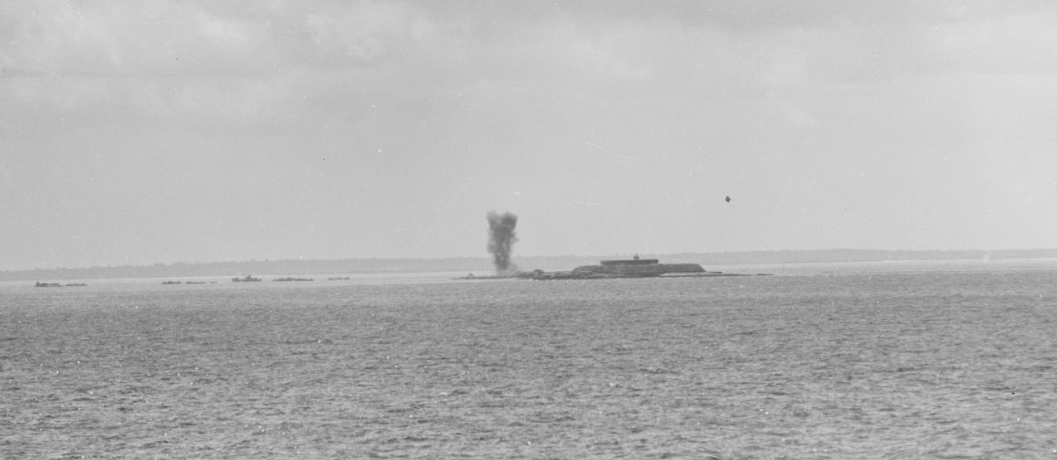
At 0633, while shelling enemy positions beyond the beach and simultaneously attempting to avoid German fire, Corry fouled a mine almost directly amidships. According to the official report the mine’s explosion caused immediate flooding in the forward engine and fire room. Firsthand accounts reported that when the mine exploded “floor plates were torn lose and the sound of rushing water” could be heard. The destroyer’s situation quickly deteriorated as she lost all electrical power and her rudder jammed. The resulting mechanical malfunctions came just as she was trying to make a hard-right turn at high speed—as a result she was sent into a circling movement among the waves. Hand steering eventually got her headed back out to sea but by then she had lost all steam. Her captain and crew acted quickly and courageously as “boats were lowered in[to] the water for purposes of towing the destroyer through shoal water.”
Corry was broken amidships and sagging badly. As water reached her main deck, at approximately 0639, Lt. Cmdr. Hoffman, the commanding officer, passed the word to prepare to abandon ship. Moments later the deck was under nearly two feet of water and her crew expeditiously abandoned ship—with the captain being the last to depart, an act of leadership that later earned him a Silver Star. Corry’s remains protruded from roughly six fathoms of water and her crew clung to anything that could float, as they were set adrift in the waves around her.
According to an account of German operations during the Allied landings in Normandy, written by Vice Adm. Fredrich Ruge of the Federal German Navy, the German naval battery that was engaging Corry on that trying day was a 210 millimeter shore battery located at Ft. St. Marcouf, east of Cherbourg. The Germans believed that the battery’s gunfire sank Corry, in conjunction with a subsequent collision with a mine. Several of Corry’s crew, both officer and enlisted also believed that she was sunk more as a result of the German’s artillery fire, than by the mine.
In a piece written later in his life, Capt. John R. Blackburn USN (Ret.), while on board Quincy (CA-71) recalled his own observation of Corry’s sinking from a short distance away, stating “the plucky little tin can was mortally wounded by the mine blast and sinking rapidly. A white mist of steam spouted up from her smokestacks.” Quincy trained her 8-inch guns on the shoreline in order to stave off German gun fire directed at Corry’s floundering crew. While some of Corry’s crew made it to small rafts or had flotation devices many sailors, such as MM2c Earnie Mckay, found themselves without. As was the case with Mckay, once the ship had settled in the water, he swam back to the wreckage in order to keep from drowning. While that action kept him from sinking, he was nonetheless, subjected to continued German shelling, which was still targeting Corry’s location even after she had been torn asunder.
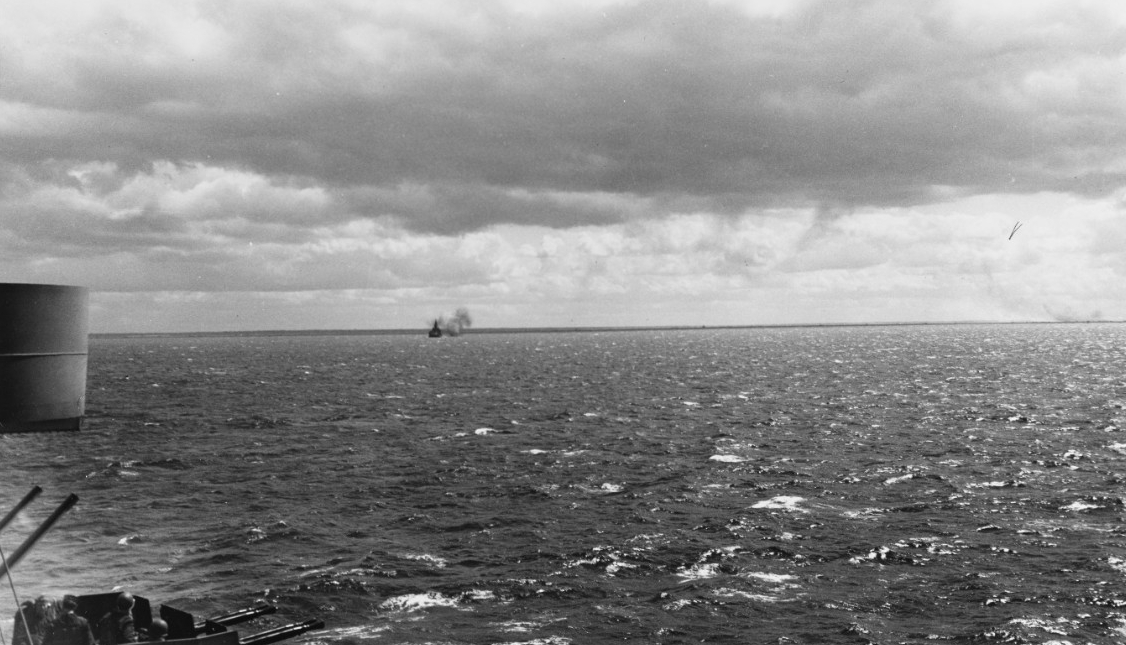
The surviving crew members spent nearly two hours in the water as German munitions continued to explode in the area, a tragic circumstance that added even more brave sailors to the list of casualties. As Lt. Cmdr. Hoffman recalled “probably the majority of the casualties occurred in the water for as late as an hour and a half after the ship had been sunk, the batteries continued to shell the men in the water.” The stranded sailors found it difficult to wrestle with the waves that pulled them both towards Corry’s wreckage, as well as towards the hostile shoreline—a circumstance, compounded by the frigid temperate of the water, which led to exposure claiming yet more lives.
For those who survived the shelling and the sea, their rescue came at long last, at 0830, when Fitch (DD-462) and Hobson entered the area and fended off the enemy shore batteries. They, along with Butler (DD-636) and PT-199 assisted in rescuing Corry’s crew. The survivors were eventually transferred to the attack transport Barnett (APA-5) and thereafter brought to the U.S. Naval Advanced Base, Falmouth, England. The crew sustained considerable casualties during the sinking. From the outset of the engagement, as early as 0630, a sailor was wounded in the left shoulder by a shell fragment that struck a near miss on the starboard side; he was the first of many. By the end of the ordeal six enlisted men lost their lives, one officer and 15 enlisted men were missing, and one officer and 32 enlisted men were injured.
The day, despite being filled with tragedy also gave witness to some remarkable acts of courage; exemplified by sailors like Lt. John Oliver Parrott who received the Navy Cross for his daring action during the tumult of the battle. Lt. Parrott, the ship’s first lieutenant, after having been given word to abandon ship, risked his life to enter the forward fire room to rescue a WT3c trapped under a grating. Despite the fact that the water in the room was mixed with oil and that the air was filled with live steam—a potentially explosive combination—Parrott pulled the enlisted man to safety, one of many valiant acts committed by American men-at-arms on that momentous day.
Corry earned four battle stars for her service in World War II: for the invasion of North Africa (8-11 November 1942); Norway raid (2-6 October 1943); operations with TG.16 (16 February-31 March 1944), during which she sank U-801; and the invasion of Normandy (6 June 1944), her final act.
Corry was stricken from the Navy Register on 29 July 1944.
| Commanding Officers | Date Assumed Command |
| Lt. Cmdr. Eugene C. Burchett | 18 December 1941 |
| Lt. Cmdr. Lot Ensey | 2 December 1942 |
| Lt. Cmdr. George D. Hoffman | 16 November 1943 |
Jeremiah D. Foster
22 May 2018


